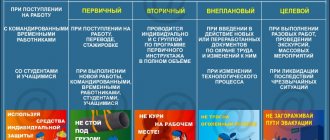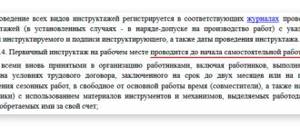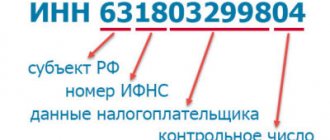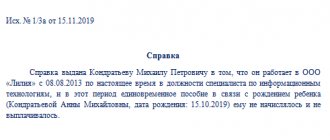The employer is obliged to provide induction training on labor protection at the enterprise. Ensuring a safe work environment for all employees should be one of the main goals of any organization. A situation in which harm to an employee’s health is caused entails a large number of difficulties in the form of inspections and fines. That is why such a course on the protection of professional activities is not just a formality, but a necessity established by current legislation. Let us consider in more detail the question of what instructions for conducting introductory training on labor protection can be used by the employer.
Why conduct induction training?
The need for all employers to instruct workers on current labor safety standards is established by Articles 212 and 225 of the Labor Code of the Russian Federation.
The instructions for introductory training on labor protection include the purpose of conducting it, which is the need to familiarize workers with a number of rules and regulations established in the institution, including:
- organizational structure;
- work schedule;
- equipment and technologies used;
- features of organizing the work of warehouses, territories, transport logistics;
- ensuring fire safety measures;
- labor safety regulations.
Each institution has its own specifics; accordingly, the rules and regulations of activity differ for each specific employer. This is precisely the reason why it is necessary to familiarize all new employees with the labor protection rules at the enterprise, and the procedure is called “induction”.
The head of the enterprise must distinguish between the terms “instruction” and “training”. During the briefing, the employee is explained the rules and regulations established in the institution. But studying is a lengthy procedure that is carried out according to a separate algorithm.
Who needs to be instructed
Joint Resolution of the Ministry of Labor of the Russian Federation and the Ministry of Education of the Russian Federation dated January 13, 2003 No. 1/29, which approved the procedure for training in occupational safety, establishes a list of employees whom the employer is obliged to instruct before starting work. These rules are established for:
- all new employees (if a person previously worked at the same enterprise, then quit and was hired again, he still goes through this procedure);
- all citizens who are seconded to the organization from other employers to work in certain areas;
- students from educational institutions sent for internship;
- other persons involved in the production processes of the enterprise.
Persons who have not completed induction training on labor protection are not allowed to work.
Who are they for?
When starting work, all newcomers undergo initial training. But time passes, and knowledge is forgotten or becomes outdated. The frequency of repeated training at the workplace is at least once every six months. This is necessary for all categories of workers, for example:
- officially registered employees after six months of work;
- coming from other companies;
- trainees (if they stayed for more than six months).
It doesn’t matter whether they work full-time, part-time, or go to seasonal work. This requirement also applies to homeworkers.
Who can be exempted from induction training?
All workers must be instructed in labor safety, that is, no one is subject to exemption.
The opportunity to be exempted is only from the introductory briefing procedure and only for certain categories established by clause 2.1.4 of Order 1/29. By means of an administrative document, the employer has the right to exempt from undergoing initial training and not to instruct those employees whose work is not related to certain processes in the institution:
- exploitation;
- service;
- trial;
- adjustment;
- repair of equipment;
- use of electric or other tools;
- storage and use of raw materials and materials.
The list of specific positions and professions that are not subject to induction training is determined by the employer’s administrative document.
Who is undergoing initial training?
Everyone undergoes this training.
Completion of initial training is mandatory for persons starting to perform production tasks for the first time.
These include:
- Employees who recently came to the enterprise;
- Employees of the enterprise who, according to a personal statement, move from one position to another;
- Students or other persons who work under a temporary employment contract;
- Employees whose specific activities require forced transfer to another position. For example, boiler operators are registered in this specialty during the heating season, and in the summer they are transferred to boiler equipment repairmen;
- Other employees who are required to undergo initial training based on their functional responsibilities.
The initial briefing is carried out by the immediate supervisor.
Who conducts
Training procedure 1/29 dated January 13, 2003 determines that the following are authorized to instruct in occupational safety:
- OT specialist in the organization;
- an employee (or authorized person) who performs such duties on the orders of the employer;
- directly the head of the enterprise.
The Ministry of Labor of the Russian Federation, in its Letter No. 15-2/OOG-2884 dated 08/09/2016, explained that, regardless of the presence or absence of an occupational safety specialist in an institution, the employer has the right to authorize any other person - an employee - to perform such functionality, but under one condition: the latter must be trained and successfully pass a knowledge test regarding occupational safety requirements in a training organization accredited in accordance with Order of the Ministry of Health of the Russian Federation dated April 1, 2010 No. 205n.
If a situation arises in which the head of the institution is the only participant, and an employment agreement has been concluded with him, he has the right to instruct himself (in the absence of another authorized person). This explanation is given in the Letter of Rostrud dated April 27, 2017 No. PG/08346-03-3.
Timing and duration of induction training
The employer must conduct an induction course on the day the person is actually hired by the organization. Such clarifications are given by the Ministry of Labor of the Russian Federation in Recommendations dated 05.05.2017 No. 15-2/OOG-1277. But the job applicant is not an employee of the enterprise, and occupational safety procedures should not be carried out against him.
The employer should not forget that in addition to the induction (a sample of the induction briefing on labor protection in 2021 and samples of the necessary documents are given below), the legislator established the initial briefing, which must be carried out directly at the person’s place of work, after the induction and before the start of admission to independent activity.
The duration of the procedure is determined by the program developed and approved by the institution, taking into account the specifics of its activities. As a rule, the time can range from 4 hours to 2 days (working days). It depends on the complexity and volume of processes in the organization.
Types of occupational safety briefings
In accordance with Art. 225 of the Labor Code of the Russian Federation, all employees (including heads of organizations and individual entrepreneurs) are required to undergo occupational safety training and knowledge testing. Training for ordinary employees is carried out in the form of briefings.
Briefing is a training procedure that addresses safety issues in the organization, as well as at each workplace. Completing it will allow the employee to remember the dangers that he may encounter during work and their consequences. A knowledge test at the end of training reinforces the material covered. Ideally, a trained worker should use the equipment correctly, not violate labor safety requirements, and follow the rules of technical safety regulations.
The conditions for conducting, the list of existing occupational safety briefings and their contents are listed in the “Procedure for OSH training...”, approved. joint Resolution of the Ministry of Labor and the Ministry of Education of the Russian Federation dated January 13, 2003 No. 1/29, as well as GOST 12.0.004-90 SSBT. As stated in Art. 212, persons who have not completed training, internship (from 2 to 14 shifts) and knowledge testing are not allowed to work.
Therefore, we will consider in more detail what types of occupational safety briefings there are and in what cases they are carried out.
Introductory
Introductory training on occupational safety is carried out on the first day of work:
- with all persons hired;
- with employees seconded to the organization;
- with workers of third-party organizations performing work on the territory of the enterprise;
- with trainees, etc.
Conducting introductory briefings on occupational safety is the responsibility of an occupational safety specialist or an employee appointed by decree of the manager.
During it, workers study:
- main provisions of legislation relating to occupational safety;
- rules of conduct at work;
- PPE;
- information about emergency situations in the company or similar enterprises;
- procedure for admission to independent work, etc.
What types of occupational safety training are carried out besides those we discussed above? These are primary workplace, repeated, unscheduled and targeted briefings. These types of safety and labor protection briefings are carried out by the worker’s immediate supervisor, who has undergone occupational safety training and knowledge testing.
Primary
Initial instruction on occupational safety in the workplace is carried out by the head of the unit or, on his instructions, by the foreman.
It is carried out before independent work:
- with all the newcomers;
- seasonal workers;
- with employees with whom a fixed-term contract has been concluded for a period of up to 2 months;
- with displaced or transferred employees;
- with posted workers;
- with interns;
- with persons who are entrusted with performing work that is new to them, etc.
Persons whose work is not associated with danger may be exempt from this type of instruction.
The training program includes:
- general familiarization with the technological process at the work site;
- familiarization with the equipment;
- procedure for preparing for work;
- PPE requirements;
- cases of industrial injuries and their causes;
- safety requirements when working with electrical equipment and lighting devices;
- first aid measures;
- liability for violation of OT rules.
Induction and initial training at the workplace are carried out according to specially developed and approved programs by the employer.
Repeated
The goal is to consolidate previously acquired knowledge. Conducted according to initial training programs at the workplace.
All employees specified in the previous paragraph undergo repeated training on occupational safety. It is carried out at least once every 6 months. For workers servicing high-risk equipment, it is carried out at least once every 3 months. Workers whose activities do not involve danger may be exempt from this activity. But in order to document this, the boss is obliged to issue a corresponding order.
Unscheduled
Unscheduled safety training is required:
- upon the introduction of new or amended standards containing occupational safety requirements, as well as instructions on occupational safety;
- when changing technological processes, replacing or upgrading equipment and other factors affecting labor safety;
- in case of violation of labor safety requirements by workers, if this caused an accident or accident;
- at the request of regulatory authorities;
- during breaks in work. For work with harmful and (or) dangerous conditions - more than 30 calendar days, and for others - more than 2 months;
- at the discretion of the employer.
Target
It is carried out for certain tasks:
- when performing one-time work;
- when eliminating the consequences of accidents, emergencies;
- when performing work for which a permit or permit is issued;
- when holding mass events at the enterprise.
So, we have reviewed the list of existing occupational safety instructions. The fact that an employee has undergone one or another instruction is recorded in special journals and confirmed by the signatures of the instructor and the person being instructed.
Each type of training ends with testing the employee’s knowledge and skills in safe working methods. The instructor checks your knowledge. Persons who show unsatisfactory test results are not allowed to work independently and are required to undergo training again.
Sample introductory training program on occupational safety and health
The program is not a document of extreme complexity. This is a list of questions that should be brought to the attention of the employee, as well as the amount of time allocated for studying a particular section.
An example program could look like this:
| N p/p | Subject | Duration (in hours) |
| 1 | General information about the organization, characteristic features of production activities. Location of departments and auxiliary premises | 0,25 |
| 2 | Basic provisions of labor and occupational safety legislation. Employment contract. Inner order rules. Working time and rest time. Guarantees and compensations. Discipline and responsibility for its violation | 0,30 |
| 3 | OT in the organization. State supervision and public control over her condition | 0,15 |
| 4 | Responsibilities of the employee regarding occupational safety. Fire, industrial, transport safety. Electrical safety requirements. Rules of conduct on the territory of the organization | 0,45 |
| 5 | Working conditions. Dangerous and harmful production factors characteristic of this production. Collective and individual protective equipment. Measures to prevent occupational diseases | 0,25 |
| 6 | Basic requirements for industrial sanitation and personal hygiene. Procedure and standards for issuing personal protective equipment | 0,15 |
| 7 | Circumstances and causes of typical accidents, accidents, fires, acute poisonings, injuries. Methods, ways and means of preventing them. Actions of the employee when they occur | 0,25 |
| 8 | First aid for victims | 0,5 |
| 9 | Procedure for investigation and registration of accidents and occupational diseases. Social security for victims at work | 0,20 |
| Total | 2,5 | |









